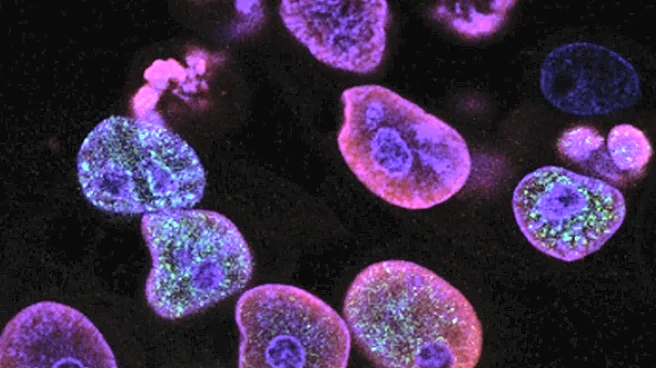What's Happening?
A recent study has employed bioinformatics approaches to identify key genes associated with NOD1 and Endoplasmic Reticulum stress (ERS) in Hepatitis B virus-induced acute liver failure (HBV-ALF). The research highlights five genes with distinct expression patterns: CFTR, DERL3, and NOD1 were significantly upregulated, while DNAJB9 and SEL1L were downregulated. These findings suggest a complex interplay between ERS and immune-inflammatory responses during HBV infection. The study also explored the role of these genes in immune cell infiltration, noting significant correlations with M1 macrophages, plasma cells, and neutrophils. The research underscores the importance of understanding gene expression profiles to potentially mitigate the high mortality rate associated with ALF, which often requires liver transplantation due to rapid disease progression.
Why It's Important?
The identification of these key genes in HBV-ALF is crucial for developing targeted therapies and improving patient outcomes. Acute liver failure has a mortality rate exceeding 50%, and current treatments focus primarily on supportive care. Understanding the genetic factors involved in the disease can lead to more effective interventions. The study's findings on immune cell interactions and gene expression profiles provide insights into the pathogenesis of HBV-ALF, potentially guiding future research and therapeutic strategies. This could benefit healthcare providers and patients by offering new avenues for treatment and management of this severe condition.
What's Next?
Future research is needed to validate the pharmacological effects and molecular mechanisms of the identified genes and potential drugs. The study suggests further investigation into the use of drugs like Lumacaftor and Tezacaftor, which target CFTR mutations, although their role in ALF remains unclear. Additionally, the study calls for more comprehensive clinical samples and demographic data to better understand HBV-specific effects. Longitudinal immune monitoring and single-cell transcriptomic technologies could help reconstruct temporal immune dynamics and stage-specific regulatory networks, minimizing interference from non-immune components.
Beyond the Headlines
The study highlights the potential for bioinformatics to uncover complex genetic interactions in diseases like HBV-ALF. It also points to the need for integrating spatial transcriptomics and multi-omics methodologies to advance understanding of disease mechanisms. The research opens up discussions on the ethical implications of genetic research and personalized medicine, particularly in the context of high-mortality diseases where rapid intervention is critical.











